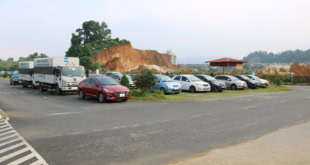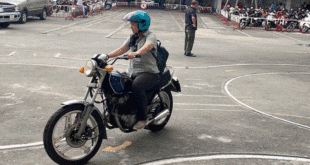Đậu xe là một kỹ năng quan trọng trong việc lái xe, đòi hỏi người lái phải có khả năng điều khiển xe một cách chính xác và an toàn để đưa xe vào vị trí đỗ phù hợp.
Theo các chuyên gia quy hoạch đô thị (Urban planning experts) đề cập rằng việc đỗ xe ô tô chiếm dụng diện tích đất đáng kể trong đô thị, lên đến 60% ở một số khu vực [Số liệu theo Hiệp hội Kỹ sư Giao thông Vận tải Hoa Kỳ (Institute of Transportation Engineers – ITE)]. Điều này dẫn đến giảm diện tích dành cho cây xanh, đường đi bộ và các hoạt động cộng đồng.
Kỹ năng đậu xe tốt không những đảm bảo an toàn cho người và phương tiện, tuân thủ luật giao thông, tiết kiệm thời gian, công sức mà còn thể hiện ý thức văn minh của người lái xe. Khi không nắm vững các kỹ thuật đậu xe, người điều khiển có thể gặp khó khăn trong việc căn chỉnh và di chuyển xe, dẫn đến nhiều sự va chạm không đáng có.
Có khá nhiều tình huống, vị trí đậu xe khác nhau, người điều khiển phải thuần thục các kỹ thuật đậu xe cơ bản như đậu xe song song, ghép xe vào ô, chạy xe vào chuồng. Bên cạnh đó, cần nâng cao thêm các kỹ năng đậu xe trên dốc, đậu xe song song hẹp và đậu xe vào bãi đậu đông. Có như vậy, dù gặp trường hợp nào thì cũng đậu xe đúng cách bất chấp độ khó.
Đặc biệt, nên lưu ý tuân thủ đúng luật giao thông, sử dụng sự giúp đỡ của gương chiếu hậu, camera, xi nhan cũng như nắm một vài mẹo để hoàn thành đậu xe một cách hiệu quả.
Kỹ năng đậu xe tốt giúp bạn tự tin hơn khi lái xe và tránh được những tình huống va chạm đáng tiếc. Theo dõi ngay bài viết để bỏ túi cho mình những kiến thức và kỹ năng cần thiết để đậu xe an toàn và hiệu quả trong mọi tình huống nhé.

Tại Sao Cần Đậu Xe Đúng Cách?
Đậu xe ô tô đúng cách mang lại sự an toàn cho bản thân và những người xung quan, tuân thủ luật giao thông, tiết kiệm thời gian – công sức và bảo vệ xe hiệu quả.
- An toàn cho bản thân và người khác: Đậu xe đúng cách giúp giảm thiểu nguy cơ va chạm với các phương tiện khác, người đi bộ và các chướng ngại vật. Không những thế còn giúp bạn dễ dàng ra khỏi vị trí đỗ xe và di chuyển xe an toàn hơn.
- Tuân thủ luật giao thông: Đậu xe đúng cách là việc làm tuân thủ luật giao thông, tránh bị phạt tiền và xử phạt. Góp phần tạo nên môi trường giao thông an toàn và văn minh. Đồng thời cũng thể hiện ý thức và trách nhiệm của người lái xe.
- Tiết kiệm thời gian và công sức: Biết cách đậu xe đúng sẽ giúp bạn không phải mất nhiều thời gian tìm kiếm chỗ đậu xe, ảnh hưởng và gây cản trở đến những người xung quanh. Quá trình di chuyển từ đó cũng nhanh chóng và thuận tiện hơn.
- Bảo vệ xe: Đậu xe đúng chỗ, đúng cách là việc làm giúp bảo vệ xe khỏi bị va chạm, trầy xước, hư hỏng.
Hãy thử tưởng tượng, nếu không nắm được các kỹ thuật đậu xe bạn có thể khó khăn trong việc căn chỉnh xe và di chuyển, dẫn đến nhiều sự va chạm không đáng có. Đồng thời có thể ảnh hưởng đến tâm lý, gây căng thẳng khi không xử lý được một vài tình huống giao thông trong điều kiện phức tạp và điều kiện thời tiết xấu, đây có thể là nguyên nhân gây ra tai nạn và nguy hiểm cho bản thân.
Một nghiên cứu của Đại học Clemson (Clemson University) cho thấy việc tìm kiếm chỗ đỗ xe khó khăn có thể gây ra căng thẳng và bực bội cho người lái xe, dẫn đến gia tăng mức độ hormone cortisol – hormone gây stress
Chính vì vậy, việc học hỏi và rèn luyện kỹ năng đậu xe là vô cùng quan trọng để đảm bảo an toàn và nâng cao trải nghiệm lái xe.
Hướng Dẫn Các Kỹ Thuật Đỗ Xe Cơ Bản
Có khá nhiều kỹ thuật đậu xe cơ bản mà người điều khiển phương tiện cần rèn luyện và nắm vững như đậu xe song song, ghép xe vào ô, ghép xe vào chuồng. Dưới đây là các bước hướng dẫn các kỹ thuật trên một cách cẩn thận để giúp người lái xe an toàn vào vị trí.
1. Đậu xe song song
Đỗ xe song song là kỹ năng quan trọng mà bất kỳ tài xế nào cũng cần nắm vững. Kỹ năng này giúp bạn đỗ xe an toàn và hiệu quả trong những không gian hẹp.
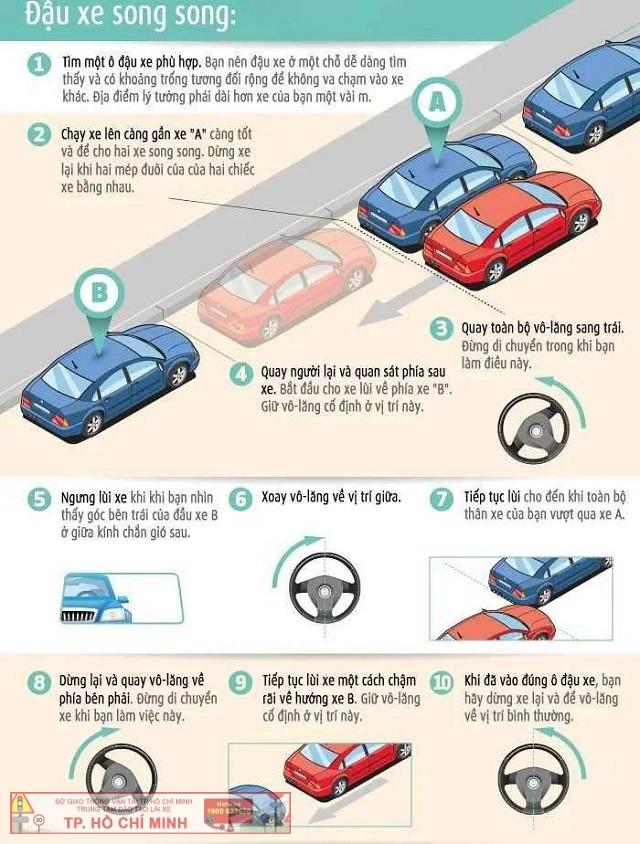
Để hoàn thành tốt kỹ năng này, bạn thực hiện theo các bước
Bước 1: Tìm kiếm vị trí đỗ xe phù hợp
- Tìm kiếm chỗ đỗ xe song song dài hơn xe của bạn khoảng 1-2 mét.
- Chỗ đỗ xe nên có khoảng trống rộng rãi để bạn dễ dàng di chuyển và tránh va chạm với các xe khác.
Bước 2: Đưa xe vào vị trí ban đầu
- Chạy xe song song với xe đang đỗ (xe A) và giữ khoảng cách khoảng 60 cm.
- Dừng xe khi mép đuôi xe của bạn bằng với mép đuôi xe A.
Bước 3: Chuẩn bị lùi xe
- Quay vô lăng sang trái hết cỡ.
- Giữ nguyên vị trí vô lăng và bắt đầu lùi xe.
Bước 4: Lùi xe và căn chỉnh vị trí
- Quan sát gương chiếu hậu và camera quan sát để theo dõi khoảng cách giữa xe của bạn và xe A.
- Lùi xe cho đến khi bạn nhìn thấy góc bên trái của đầu xe B xuất hiện ở giữa kính chắn gió sau.
Bước 5: Chỉnh lái và tiếp tục lùi
- Quay vô lăng về vị trí trung tâm.
- Tiếp tục lùi xe cho đến khi thân xe của bạn vượt qua xe A.
Bước 6: Hoàn tất việc lùi xe
- Dừng lại và quay vô lăng sang phải hết cỡ.
- Lùi xe một cách chậm rãi cho đến khi xe vào vị trí đỗ song song.
Bước 7: Điều chỉnh vị trí xe
- Chỉnh lái và di chuyển xe sao cho xe nằm chính giữa vị trí đỗ, cách đều xe A và xe B.
- Bật số N, kéo phanh tay và tắt xi nhan.
Khi thực hiện kỹ thuật, sử dụng gương chiếu hậu và camera lùi để quan sát xung quanh xe. Nhớ bật đèn báo nguy hiểm khi đỗ xe và kéo phanh tay khi đỗ.
2. Ghép xe vào ô (lùi xe vào chuồng)
Ghép xe vào ô (lùi xe vào chuồng) đòi hỏi người điều khiển phải có sự phối hợp nhịp nhàng giữa tay lái, chân ga và chân phanh.
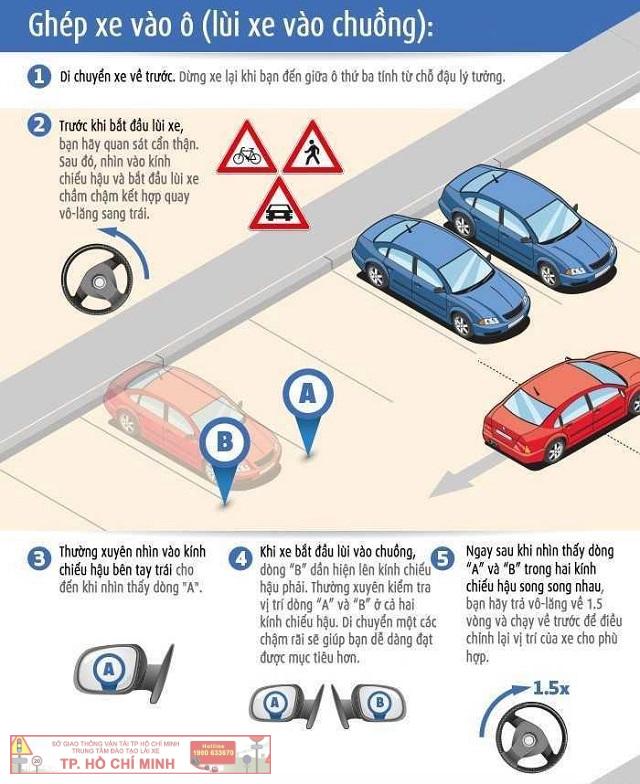
Lùi xe vào chuồng an toàn nên làm theo hướng dẫn:
Bước 1: Đưa xe vào vị trí ban đầu
Di chuyển xe về phía trước cho đến khi vị trí giữa xe của bạn ngang với vạch kẻ đường thứ 3 tính từ vị trí đỗ xe lý tưởng.
Bước 2: Chuẩn bị lùi xe
- Bật xi nhan phải để báo hiệu cho các phương tiện khác biết ý định của bạn.
- Quan sát kỹ lưỡng xung quanh, đặc biệt là các phương tiện đang di chuyển.
- Nhìn vào gương chiếu hậu và bắt đầu lùi xe chậm rãi.
- Đồng thời, quay vô lăng sang trái hết cỡ.
Bước 3: Lùi xe và căn chỉnh vị trí
- Tiếp tục lùi xe cho đến khi bạn nhìn thấy vạch kẻ đường “A” xuất hiện ở giữa gương chiếu hậu bên trái.
- Giữ nguyên vị trí vô lăng và tiếp tục lùi xe.
Bước 4: Chỉnh lái và hoàn tất việc lùi xe
- Khi vạch kẻ đường “B” xuất hiện ở giữa gương chiếu hậu bên phải, hãy trả vô lăng về vị trí 1,5 vòng.
- Chạy xe tiến lên một chút để điều chỉnh vị trí xe nằm chính giữa vạch kẻ đường và song song với lề đường.
- Dừng xe, tắt xi nhan và kéo phanh tay.
Thực hiện kỹ thuật này, bạn nên tưởng tượng một đường thẳng nối mép bánh xe ngoài của 2 chiếc xe bên cạnh. Lùi xe cho đến khi bánh xe phía trong của bạn chạm vào đường thẳng này. Nhớ sử dụng gương chiếu hậu để căn chỉnh vị trí xe so với vạch kẻ ô. Kỹ thuật này cần rèn luyện thường xuyên.
3. Ghép xe vào chuồng (chạy xe vào chuồng)
Ghép xe vào chuồng cũng đòi hỏi có sự phối hợp nhịp nhàng giữa tay lái, chân ga và chân phanh. Có hai loại ghép xe vào chuồng phổ biến là ghép xe vào chuồng dọc và ghép xe vào chuồng ngang.
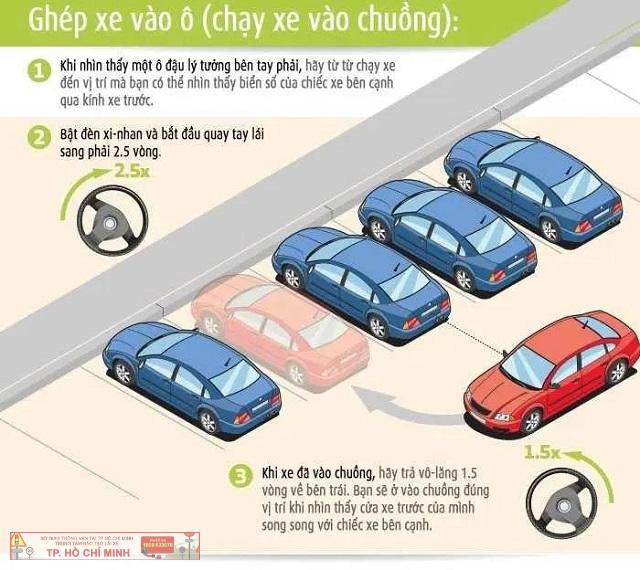
Hướng dẫn cách ghép xe vào chuồng bất chấp độ khó:
Bước 1: Tìm kiếm vị trí đỗ xe phù hợp
- Quan sát cẩn thận và tìm kiếm vị trí đỗ xe vuông góc bên tay phải đủ rộng cho xe của bạn.
- Tiếp cận vị trí đỗ xe từ từ, chú ý giữ khoảng cách an toàn với các phương tiện xung quanh.
- Dừng xe khi bạn có thể nhìn thấy biển số xe bên cạnh qua kính cửa trước.
Bước 2: Bắt đầu thực hiện thao tác
- Bật xi-nhan phải để báo hiệu cho các phương tiện khác biết ý định của bạn.
- Quay vô lăng sang phải 2,5 vòng một cách dứt khoát nhưng nhẹ nhàng.
- Giữ nguyên vị trí vô lăng và bắt đầu lùi xe từ từ vào chuồng.
Bước 3: Chỉnh lái và hoàn tất
- Khi xe đã đi được một nửa chuồng, hãy trả vô lăng 1,5 vòng về bên trái.
- Tiếp tục lùi xe và điều chỉnh vị trí xe sao cho song song với xe bên cạnh.
- Dừng xe khi cửa xe trước của bạn và cửa xe bên cạnh song song nhau.
- Tắt xi-nhan và hoàn tất việc đậu xe.
Khi ghép xe vào chuồng hãy quan sát gương chiếu hậu và camera lùi để nắm rõ vị trí và chướng ngại vật. Bẻ lái đúng hướng. đúng thời điểm và phanh luôn đạp nhẹ để kiểm soát tốc độ lùi.
Hướng Dẫn Các Kỹ Thuật Đậu Xe Nâng Cao
Ngoài các kỹ thuật đậu xe cơ bản, người điều khiển phương tiện cũng gặp các thử thách lớn đối với kỹ thuật đậu xe nâng cao như đỗ xe trên dốc, đỗ xe xuống dốc, đậu xe song song hẹp, đậu xe trong bãi đỗ xe đông đúc. Dưới đây là các bước hướng dẫn chuẩn giúp bạn có thể vượt qua các kỹ thuật nâng cao trên một cách dễ dàng.
1. Đậu xe trên dốc
Đỗ xe trên dốc có thể là một thử thách đối với nhiều người lái xe, đặc biệt là những người mới bắt đầu. Tuy nhiên, với một số kỹ thuật đơn giản, bạn có thể thực hiện việc này một cách dễ dàng và an toàn.
Chi tiết các kỹ thuật đậu xe trên dốc:
– Đỗ xe lên dốc:
Bước 1: Chọn vị trí đỗ xe có đủ không gian và bằng phẳng.
Sử dụng phanh tay để giữ xe cố định và bật xi nhan để báo hiệu cho các phương tiện khác biết ý định của bạn. Sử dụng phanh tay để giữ xe cố định.
Bước 2: Lùi xe vào chuồng
- Bật số lùi và từ từ lùi xe vào chuồng.
- Giữ vô lăng thẳng để xe di chuyển song song với lề đường.
- Sử dụng gương chiếu hậu và camera quan sát để theo dõi khoảng cách giữa xe và các phương tiện xung quanh.
Bước 3: Hoàn tất
- Khi xe đã vào chuồng, hãy trả số về N và kéo phanh tay.
- Chèn bánh xe chặn hoặc sử dụng đá kê bánh để đảm bảo xe không bị trôi.
– Đỗ xe xuống dốc:
Bước 1: Chuẩn bị:
- Chọn vị trí đỗ xe có đủ không gian và bằng phẳng.
- Bật xi nhan để báo hiệu cho các phương tiện khác biết ý định của bạn.
- Sử dụng phanh tay để giữ xe cố định.
Bước 2: Lùi xe vào chuồng:
- Bật số lùi và từ từ lùi xe vào chuồng.
- Quay vô lăng sang trái để xe di chuyển song song với lề đường.
- Sử dụng gương chiếu hậu và camera quan sát để theo dõi khoảng cách giữa xe và các phương tiện xung quanh.
Bước 3: Hoàn tất:
- Khi xe đã vào chuồng, hãy trả số về N và kéo phanh tay.
- Chèn bánh xe chặn hoặc sử dụng đá kê bánh để đảm bảo xe không bị trôi.
2. Đậu xe song song hẹp
Những người mới bắt đầu lái xe rất e ngại việc đậu xe song song hẹp bởi đây là một kỹ thuật khó. Để thực hiện được đỗ xe song song hẹp, đòi hỏi phải có sự phối hợp nhịp nhàng giữa tay lái, chân ga, chân phanh và quan sát thật tốt mới đảm bảo được an toàn.
Dưới đây là hướng dẫn chi tiết kỹ thuật đỗ xe song song hẹp:
Bước 1: Tìm kiếm vị trí đỗ xe phù hợp:
- Tìm kiếm chỗ đỗ xe song song dài hơn xe của bạn khoảng 1-2 mét.
- Chỗ đỗ xe nên có khoảng trống rộng rãi để bạn dễ dàng di chuyển và tránh va chạm với các xe khác.
- Bật xi nhan để báo hiệu cho các phương tiện khác biết ý định của bạn.
Bước 2: Đưa xe vào vị trí ban đầu
- Chạy xe song song với xe đang đỗ (xe A) và giữ khoảng cách khoảng 60 cm.
- Dừng xe khi mép đuôi xe của bạn bằng với mép đuôi xe A.
Bước 3: Chuẩn bị lùi xe
- Quay vô lăng sang trái hết cỡ.
- Giữ nguyên vị trí vô lăng và bắt đầu lùi xe.
Bước 4: Lùi xe và căn chỉnh vị trí
- Quan sát gương chiếu hậu và camera quan sát để theo dõi khoảng cách giữa xe của bạn và xe A.
- Lùi xe cho đến khi bạn nhìn thấy góc bên trái của đầu xe B xuất hiện ở giữa kính chắn gió sau.
Bước 5: Chỉnh lái và tiếp tục lùi
- Quay vô lăng về vị trí trung tâm.
- Tiếp tục lùi xe cho đến khi thân xe của bạn vượt qua xe A.
Bước 6: Hoàn tất việc lùi xe
- Dừng lại và quay vô lăng sang phải hết cỡ.
- Lùi xe một cách chậm rãi về hướng xe B. Giữ vô lăng cố định ở vị trí này.
- Khi đã vào đúng ô đậu xe, bạn hãy dừng xe lại và để vô lăng về vị trí bình thường.
Để đậu xe song song hẹp đúng cách, bạn có thể tham khảo mẹo mở cửa sổ hoặc đặt một chiếc khăn hoặc gối trên ghế lái để cảm nhận được vị trí của xe khi lùi.
3. Đậu xe trong bãi đỗ xe đông đúc
Đậu xe trong bãi đỗ xe đông đúc có thể là một thử thách, đặc biệt là khi bạn mới lái xe hoặc không quen với việc lái xe trong không gian hẹp. Tuy nhiên bạn đừng lo lắng, áp dụng theo các bước sau sẽ có thể đậu xe an toàn và hiệu quả.
Trước khi vào bãi đỗ xe phải quan sát thật kỹ xung quanh để tìm kiếm chỗ đỗ phù hợp. Hãy chú ý đến các biển báo và vạch kẻ đường để đảm bảo bạn đỗ xe đúng quy định.
Các bước đậu xe:
Bước 1: Tìm kiếm vị trí đỗ xe phù hợp
- Lái xe chậm rãi và quan sát cẩn thận các vị trí đỗ xe trống.
- Chọn vị trí đỗ xe đủ rộng cho xe của bạn và dễ dàng di chuyển vào và ra.
- Tránh đỗ xe gần các cột, tường hoặc các xe khác quá gần.
Bước 2: Bật xi nhan và ra tín hiệu
- Bật xi nhan để báo hiệu cho các phương tiện khác biết ý định của bạn.
- Nhìn vào gương chiếu hậu và quan sát xung quanh để đảm bảo an toàn trước khi chuyển hướng.
Bước 3: Đưa xe vào vị trí
- Sử dụng gương chiếu hậu và camera quan sát để căn chỉnh xe vào vị trí đỗ.
- Di chuyển chậm rãi và cẩn thận để tránh va chạm với các xe khác.
- Sử dụng vô lăng và phanh để điều chỉnh vị trí xe cho phù hợp.
Bước 4: Hoàn tất việc đỗ xe
- Dừng xe khi đã vào đúng vị trí đỗ.
- Kéo phanh tay và tắt máy.
- Gập gương chiếu hậu và khóa cửa xe.
Mẹo để hoàn thành đậu xe vào bãi xe đông đúc là hãy thật bình tĩnh, đừng vội vàng và điều chỉnh vị trí xe thật cẩn thận.
Lưu Ý Khi Đỗ Xe Ô Tô Đúng Cách?
Đậu xe là một kỹ năng quan trọng khi lái xe, tuy nhiên, đậu xe đúng cách đôi khi lại là một thử thách đối với nhiều người. Vì vậy nên tuân thủ luật giao thông, biển báo, sử dụng đúng tác dụng của gương chiếu hậu, camera lùi, xi nhan,… để đảm bảo an toàn cho bản thân, người khác và phương tiện.
Các nhà nghiên cứu an toàn giao thông (Traffic safety researchers) chỉ ra rằng kỹ năng đỗ xe kém có thể góp phần gây ra tai nạn, đặc biệt là va chạm với xe khác hoặc người đi bộ khi lùi xe.
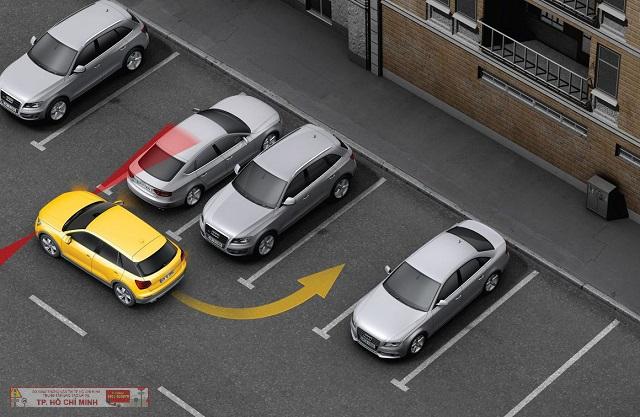
Một vài lưu ý cụ thể khi đậu xe:
– Tuân thủ luật giao thông và biển báo:
- Đậu xe đúng quy định tại các vị trí được phép.
- Tuân thủ các biển báo cấm, hạn chế đỗ xe.
- Không đỗ xe chắn lối đi, cản trở giao thông.
- Đảm bảo xe không che khuất tầm nhìn của các phương tiện khác.
– Sử dụng gương chiếu hậu, camera quan sát và bật xi nhan:
- Gương chiếu hậu và camera quan sát là những công cụ hỗ trợ đắc lực giúp bạn đậu xe an toàn.
- Sử dụng gương chiếu hậu để căn chỉnh xe và quan sát các phương tiện xung quanh.
- Sử dụng camera quan sát để quan sát những điểm mù mà gương chiếu hậu không thể nhìn thấy.
- Bật xi nhan để báo hiệu cho các phương tiện khác biết ý định của bạn khi đỗ xe.
Ngoài ra, bạn cũng cần lưu ý một số điều sau:
- Khóa cửa xe cẩn thận khi đỗ xe để đảm bảo an ninh.
- Di chuyển chậm rãi và cẩn thận khi đậu xe.
- Giữ khoảng cách an toàn với các phương tiện khác.
- Sử dụng phanh xe để điều chỉnh tốc độ và dừng xe an toàn.
- Không để đồ đạc có giá trị trên xe khi đỗ xe.
- Tắt máy xe khi đỗ xe trong thời gian dài.
- Đỗ xe ở những nơi có ánh sáng tốt và dễ quan sát.
- Khi đỗ xe trên dốc, hãy sử dụng phanh tay và chèn bánh xe để đảm bảo xe không bị trôi.
Bằng cách tuân thủ những lưu ý trên, bạn có thể đảm bảo an toàn cho bản thân, người khác và tuân thủ luật giao thông khi đậu xe.
Những Câu Hỏi Phổ Biến Liên Quan Đến Kỹ Năng Đậu/ Đỗ Xe
1. Làm thế nào để tìm vị trí đậu xe phù hợp?
Để tìm vị trí đậu xe phù hợp, bạn nên quan sát xung quanh và tìm kiếm các biển báo “Cho phép đỗ xe”. Tránh đậu xe gần các khu vực cấm, khu vực nguy hiểm hoặc khu vực dành cho người khuyết tật (thường sẽ có biển báo cấm). Đặc biệt, nên chọn những vị trí có đủ diện tích cho xe của bạn để vừa đảm bảo được đậu xe nhanh chóng, dễ dàng, vừa không gây “nguy hiểm” cho xe lẫn người.
2. Những lỗi phổ biến thường gặp khi đậu xe?
Khi đậu xe, người điều khiển phương tiện rất hay mắc các lỗi sau:
- Đậu xe không đúng vị trí, gây cản trở giao thông.
- Không sử dụng xi-nhan.
- Không đánh lái cẩn thận, dẫn đến va chạm.
- Không chú ý quan sát xung quanh.
3. Làm thế nào để đậu xe thuần thục?
Để đậu xe một cách thuần thục, người điều khiển nên nắm vững các kỹ thuật đậu, tăng cường khả năng quan sát và sử dụng gương chiếu hậu – xi nhan – camera lùi, luyện tập thường xuyên. Hơn hết luôn giữ tâm thế bình tĩnh và tập trung. Cụ thể:
– Nắm vững kỹ thuật:
- Hiểu rõ từng bước trong kỹ thuật đậu xe, bao gồm cách đánh lái, điều chỉnh vị trí xe, sử dụng gương chiếu hậu và phanh.
- Tham khảo tài liệu và xem video hướng dẫn, đọc sách hướng dẫn để nắm rõ kỹ thuật.
– Tăng cường khả năng quan sát:
- Sử dụng gương chiếu hậu hoặc camera hiệu quả để xác định vị trí xe và các chướng ngại vật xung quanh.
- Quan sát trực tiếp những điểm mà gương chiếu hậu không thể nhìn thấy.
- Chú ý đến vạch kẻ đường xác định vị trí xe và đỗ xe đúng quy định.
– Luyện tập trong nhiều tình huống:
- Luyện tập ở nhiều địa điểm với các điều kiện khác nhau giúp bạn nâng cao kỹ năng xử lý tình huống.
- Luyện tập trong điều kiện thiếu sáng, đường hẹp, dốc hoặc đông đúc giúp bạn rèn luyện kỹ năng và sự tự tin.
- Sử dụng camera 360 độ, cảm biến hỗ trợ đỗ xe để việc đậu xe dễ dàng hơn.
– Giữ bình tĩnh và tập trung:
- Hít thở sâu giúp bạn bình tĩnh và tập trung khi đậu xe.
- Tập trung vào việc lái xe và tránh bị phân tâm bởi những yếu tố bên ngoài.
- Tin tưởng vào khả năng của bản thân và thực hiện thao tác dứt khoát.
- Luyện tập thường xuyên và kiên trì là chìa khóa để bạn có thể đậu xe thuần thục trong mọi tình huống.
Ngoài ra, bạn có thể tham khảo một số kinh nghiệm lùi chuồng để đổ xe ô tô đúng cách giúp bạn có thêm nhiều kỹ năng cũng như xử lý các tình huống khó khi gặp phải.
4. Đơn vị nào đào tạo kỹ thuật đậu xe an toàn bất chấp độ khó?
Trung Tâm Đào Tạo & Sát Hạch Lái Xe TP. HCM là đơn vị uy tín trong lĩnh vực đào tạo và sát hạch bằng lái xe, bổ túc tay lái ô tô, bao gồm cả kỹ năng đậu xe trong nhiều tình huống khó.
Lý do bạn nên chọn Trung Tâm Đào Tạo & Sát Hạch Lái Xe TP. HCM:
- Đội ngũ giáo viên có nhiều năm kinh nghiệm trong lĩnh vực đào tạo lái xe, luôn tận tâm hướng dẫn học viên từng bước để có thể đậu xe an toàn và thành thạo.
- Trường được trang bị sân tập rộng rãi, hiện đại với đầy đủ các tình huống giao thông thực tế, giúp học viên có thể luyện tập kỹ năng đậu xe trong nhiều điều kiện khác nhau.
- Phương pháp đào tạo hiệu quả, kết hợp giữa lý thuyết và thực hành (sân tập, đường trường), giúp học viên dễ dàng tiếp thu kiến thức và kỹ năng.
- Chương trình đào tạo đa dạng, phù hợp với nhu cầu của học viên, bao gồm cả khóa đào tạo kỹ năng đậu xe nâng cao.
- Trường có mức học phí cạnh tranh, phù hợp với điều kiện kinh tế của nhiều học viên.
Ngoài ra, Trung Tâm Đào Tạo & Sát Hạch Lái Xe TP. HCM còn có một số ưu điểm khác như:
- Hỗ trợ học viên hoàn tất các thủ tục đăng ký thi sát hạch lái xe một cách nhanh chóng và thuận tiện.
- Cung cấp dịch vụ đưa đón học viên đến sân tập và địa điểm thi sát hạch.
- Thường xuyên có các chương trình ưu đãi học phí cho học viên.
Nếu bạn đang tìm kiếm một đơn vị uy tín để đào tạo kỹ năng đậu xe an toàn, Trung Tâm Đào Tạo & Sát Hạch Lái Xe TP. HCM là lựa chọn bạn nên tham khảo. Liên hệ đến hotline của trường để được tư vấn cụ thể về chương trình học cũng như báo giá nhé.
Trên đây là tổng hợp những chia sẻ về hướng dẫn đậu xe đúng cách, hy vọng hữu ích cho bạn đọc. Chúc bạn sớm thuần thục các kỹ năng đậu xe cơ bản và nâng cao nhé.
 Trường đào tạo & thi sát hạch lái xe tại TP Hồ Chí Minh Trường đào tạo, dạy học và thi sát hạch lái xe máy, xe oto ở Thành Phố Hồ Chí Minh
Trường đào tạo & thi sát hạch lái xe tại TP Hồ Chí Minh Trường đào tạo, dạy học và thi sát hạch lái xe máy, xe oto ở Thành Phố Hồ Chí Minh

